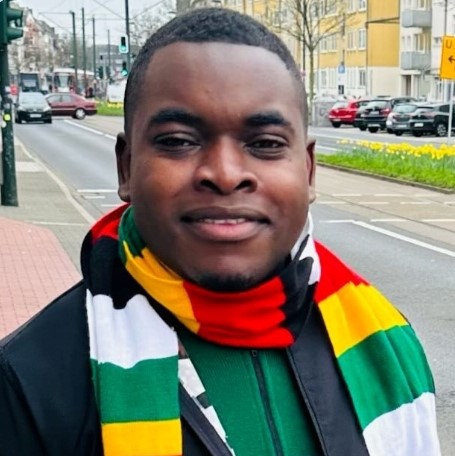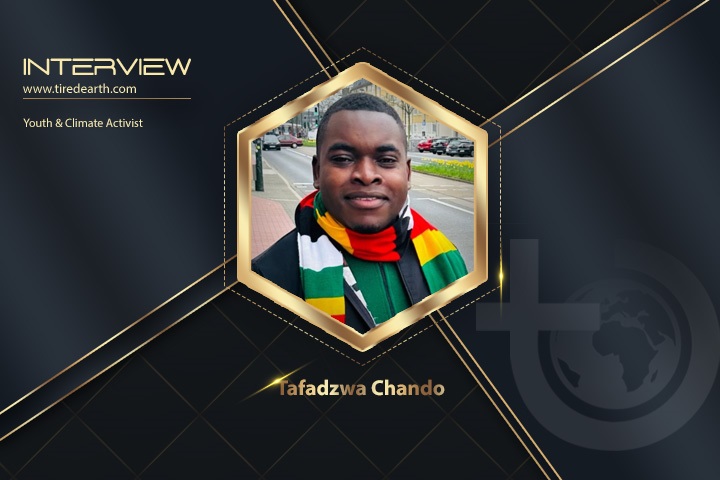13 Nov 2025

Tafadzwa Williams Chando
Zimbabwean
At Climate Live and through my other initiatives, we focus on empowering young people and communities with knowledge so they can understand climate policies, national bills, and global negotiations.

1. Tell us about your educational and professional background that led you to become the Program Director of Global Climate Live.
My journey in activism began at the age of 12, when I founded Magna Youth Action in Harare, launching environmental clubs in schools to educate young people about climate justice and sustainability. I hold an LLB and over the years, my passion for youth empowerment and climate justice grew exponentially.
In 2018, I joined the climate school strikes— which later evolved into Fridays for Future (FFF)—and helped launch the movement in various countries. Realising that school strikes often attracted arrests, intimidation, and restrictions across many regions, particularly in MAPA (Most Affected People and Areas), I partnered with Frances Fox in 2019 to start Climate Live in Zimbabwe. Soon after, I became the International Program Director, launching and supporting the initiative in over 25 countries.
To date, I have helped mobilise youth from over 50 countries to attend COPs and major climate conferences to ensure meaningful youth participation in global policy-shaping.
I am also the Founder of the Climate Refugees Initiative and the Global Climate Impact (GCI) – www.gclimateimpact.org – which support communities displaced by climate change and amplify MAPA voices in global climate diplomacy.
Professionally, I serve as the Managing Director of Solvemen Trading, where we facilitate sustainable agriculture, international trade, and renewable energy collaboration between Africa and Asia. I also lead Saver Plus, an organic adjuvant product helping farmers reduce chemical use, save costs on pesticides and fertilizers, and promote sustainable farming. Additionally, I am the founder of Chando Capital, a fintech and investment entity enabling simpler cross-border transactions and unlocking global investment and trade opportunities for African businesses.
2. What was the idea/inspiration behind creating Global Climate Live?
Climate Live emerged as a creative solution to the challenges we faced during the early days of climate strikes. With FFF, we relied heavily on direct action and protests—yet many young people, especially in MAPA countries, faced police intimidation, arrests, or state restrictions. We needed an alternative method that was safe, powerful, inclusive, and engaging.
Music and art became that bridge. Climate Live uses concerts, art, and creative cultural expression to communicate climate urgency in a way that brings people together, removes fear or barriers, and reaches communities that traditional activism does not. It allows us to inspire, educate, and mobilize large audiences—without conflict—by creating a joyful, inclusive, and empowering movement rooted in culture.
3. Zimbabwe is highly vulnerable… Tell us about your organization’s initiatives to educate a global audience about climate-change education.
Zimbabwe remains one of the most climate-impacted countries, facing droughts, cyclones, floods, and heatwaves—despite contributing less than 0.05% of global emissions. The current government, under President Mnangagwa, has made positive progress in climate adaptation, renewable energy and youth inclusion. Hosting COP15 encouraged stronger commitments on adaptation, preservation of sensitive ecosystems, and investment in climate resilience.
At Climate Live and through my other initiatives, we focus on empowering young people and communities with knowledge so they can understand climate policies, national bills, and global negotiations. Through creative campaigns, workshops, renewable energy trainings, and community dialogues, we ensure climate education is accessible and understood by grassroots communities—not only academics or policymakers.
4. Does your organization collaborate with Museums, CHN?
Yes, we do collaborate with museums and cultural heritage networks. Because Climate Live is art-driven, many of our national teams host exhibitions, creative climate showcases, concerts, public dialogues, and youth-led cultural programs in partnership with museums and creative art institutions around the world.
5. Tell us about your COP30 program – Integrating Art, Indigenous Wisdom and Science for Climate Action.
Our COP30 session focused on bridging three forces of change: Art, Indigenous Knowledge, and Science. We demonstrated how these pillars can jointly mobilise stronger climate action. We showcased community-led solutions, traditional ecological knowledge, and artistic advocacy, alongside scientific research and evidence-based climate strategies.
The session featured experts including Dr. Mary Rice from the Harvard School of Public Health, who added the science and health dimension. Art allowed participants to emotionally connect to the crisis, Indigenous wisdom offered solutions rooted in harmony with nature, and science provided the evidence and pathways for implementation.
6. What are your thoughts on the Art Meets Science initiative at Lamont-Doherty Earth Observatory of Columbia University?
The “Art Meets Science” initiative is incredibly powerful because it humanises science. Science provides data, projections, and evidence—but art transforms that knowledge into emotion, empathy, and storytelling. It shifts climate change from graphs and models into a human experience people can feel, especially concerning biodiversity loss, cultural heritage erosion, and ecosystem collapse.
This fusion is essential for inspiring public imagination, shaping narratives, and motivating action. When knowledge and emotion meet, transformation becomes possible.
7. Anything else you would like to add?
Climate solutions must be community-centred, equitable, youth-inclusive, and culturally grounded. I believe the future of climate action lies in collaboration, creativity, and justice-based partnerships, especially elevating MAPA voices, Indigenous knowledge, and local innovation.
8. How can people reach you and your organization?
I can be reached at:
📧 media@tafadzwachando.org
🔗 LinkedIn: Tafadzwa Chando
📸 Instagram: @OfficialTafadzwaChando
Comment